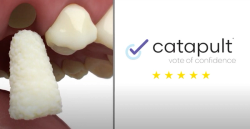- About Us
- Advertise
- Editorial
- Contact Us
- Terms and Conditions
- Privacy Policy
- Do Not Sell My Personal Information
© 2025 MJH Life Sciences™ and Dental Products Report. All rights reserved.
Technique: Kahng on creating fluorescence through shade matching
A female patient in her late 30s presented for custom shade matching at the laboratory with very specific demands. She was replacing her two natural centrals with crowns that required blending of color with her existing dentition.
A female patient in her late 30s presented for custom shade matching at the laboratory with very specific demands. She was replacing her two natural centrals with crowns that required blending of color with her existing dentition.
Her focus was on bright color and not too much translucency. As a technician, the author’s focus was directly impacted by material fluorescence and stump shade selection in order to produce the best results possible for this patient’s case.
Case study
01 In figure 1 (all figures in video below), the patient visited the lab for a custom shading appointment. The author removed the temporaries and checked the stump shade color as well as the lateral teeth’s transparency with his porcelain custom shade tabs.
More shade matching: An anterior implant case
02 He made note of several characteristics: 50 percent opacity with an A1 base and enamel opal in the middle and incisal 1/3 areas. He also noted his enamel overlay would be directed toward the gingival and incisal 1/3. But the most important factor his color matching session determined was to create the illusion of transparency with a halo effect as a key to matching the adjacent dentition.
03 In figure 2, a color check of the mandibular arch was performed on the posterior teeth in order to evaluate and check the patient’s enamel. This finding related directly to the enamel color of the maxillary teeth for comparison and the final decision on the color of the enamel overlay. The custom shade results led the author to estimate that he would need to apply more transparency to the incisal 1/3 in order to match the dentition of the lateral number 7 (fig. 3).
04 As a technician, the author will sometimes compare different products in order to determine which will give him the best results for a particular case. Figure 4 compares GC pressable materials (left side) with Ivoclar ingots (right side) and a natural tooth situated in between. The experiment was to determine which would provide the best fluorescence for this specific case.
Bench Mastery: How to foresee a restorative outcome
05 In this test, the author’s opinion was that GC’s BOO ingot color was best under the ultraviolet light, with Ivoclar Vivadent’s® MO ingot color very good as well (fig. 5). The purpose of the test was to determine which material would be best if the patient were out under fluorescent lighting in a public setting. Less fluorescence is desirable so that the teeth do not appear to be unnatural in comparison to the adjacent dentition when the patient is laughing, smiling or just talking. It can be very distracting.
06 When beginning work on the case, the author was able to utilize GC’s Low Fusing porcelain in order to achieve maximum results for his restorations, as seen in figure 6. A mirrored image of the final restorations was taken in order to compare and demonstrate the reflections and comparisons of translucency and transparency between the two restorations, with obvious color variation (figs 7, 8).
07 For further comparison of the color variation, the patient was photographed in an upside-down view with different angulation (fig. 9). In comparing the two centrals between the adjacent laterals, the author paralleled the opacity and incisal edge coloration of natural teeth numbers 7 and 10 vs. the restorations created for numbers 8 and 9.
Product roundup: Porcelain accessories
08 There is a difference between the intensity and amount of incisal edge coloration depending on which of the teeth we are comparing-7 vs. 10 or 6 vs. 11 (fig. 10). Figure 11 is a try-in for #8 only to double check the size and proportion of the teeth as well as their harmony of color. An edge-to-edge shot gave opportunity for incisal color comparison as well as maxillary/mandibular arch harmony (fig. 13).
09 Next, in a final left-side try-in view, broad, wide interproximal contact is covered (fig. 12) as well as the incisal halo color gradation and transparency in the middle 1/3 area.
Conclusion
This case study patient had high demands and expectations after her decision to have her teeth restored and her smile improved. However, as with most patients who make this choice, she was not completely sure how to explain what she hoped to accomplish. It was then up to the author to show her his own opinions about what he thought she might like to achieve. He spoke at length with her about material selection, what she could expect from each choice, and about the final design as well as color selection. He provided her with an outline of what she would see in her final restorations and, with her approval, was able to apply it to her final restoration color. She was quite happy with the results.



